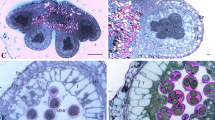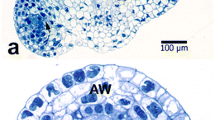Summary
The maturing pollen grains ofOphrys lutea flowers contain amyloplasts and abundant lipid droplets in their cytoplasm. Few microbodies and mitochondria are seen in the proximity of lipid droplets. In successive stages, starch mobilization is immediately followed by lipid degradation. The proliferation of microbodies, confirmed by stereological analysis, is simultaneous with lipid catabolism and vacuole formation. At this stage, clusters of 10 to 20, or more, profiles of microbodies are seen in close association with lipid droplets, instead of the isolated profiles previously observed.
Tilting of semi-thin sections of DAB treated material, followed by three-dimensional reconstruction showed that these microbody clusters constitute a microbody compartment which probably developed from a pre-existing one by budding. The cytochemical localization of lipase activity suggests a microbody role in lipid catabolism. The presence of active lipases in mitochondria, sometimes closely associated with lipid droplets, seems to indicate that mitochondria are also possibly involved in lipid metabolism.
Similar content being viewed by others
References
Carrapiço F, Pais MS (1983) Cytochemical localization of lipases during spore germination of the mossBryum capillare Hedw. Eur J Cell Biol 30: 42–46
Clarke E, Steer MW (1983) Cytoplasm structure of germinated and ungerminated pollen grains ofTradescantia virginiana. Caryologia 36: 299–305
Crang RE, Newcomb E (1969) An electron microscope study of germinatingLychnis alba pollen. Am J Bot 56: 398–405
Frederick SE, Newcomb E (1969) Cytochemical localization of catalase in leaf microbodies (peroxisomes). J Cell Biol 43: 343–352
Fringes B, Reith A (1982) Time course of peroxisome biogenesis during adaptation to mild hyperthyroidism in rat liver. Lab Invest 47: 19–26
Gorgas K (1982) Serial section analysis of peroxisomal shape and membrane relationships in the mouse preputial gland. Ann NY Acad Sci 386: 519–522
— (1984) Peroxisomes in sebaceous glands. V. Complex peroxisomes in mouse preputial gland: Serial sectioning and three-dimensional reconstruction studies. Anat Embryol 172: 261–270
— (1985) Serial section analysis of mouse hepatic peroxisome. Anat Embryol 172: 21–32
Hashimoto T (1982) Individual peroxisomal β-oxidation enzymes. Ann NY Acad Sci 386: 5–12
Hess R, Staubli W, Riess W (1965) Nature of the hepatomegalic effect produced by ethyl-chlorophenoxy-isobutyrate in the rat. Nature 208: 856–858
Hruban H, Gotoh M, Slesers A, Chou SF (1974) Structure of hepatic microbodies in rats treated with acetylsalicylic acid, clofibrate, and dimethrin. Lab Invest 30: 64–75
Huang AHC, Trelease RN, Moore TS (1983) Plant peroxisomes. Academic Press, New York.
Kawamoto S, Nozaki C, Tanaka A, Pukua S (1978) Fatty acid β- oxidation system in microbodies of n-alkane grownCandida tropicalis. Eur J Biochem 83: 609–613
Kunce C, Trelease RN, Doman DC (1984) Ontogeny of glyoxysomes in maturing and germinated cotton seeds a morphometric analysis. Planta 161: 156–164
Lazarow PB (1977) Three hypolipidemic drugs increase hepatic palmitoyl-coenzyme A oxidation in the rat. Science 197: 580–581
—,Fujiki Y (1985) Biogenesis of peroxisomes. Ann Rev Cell Biol 1: 489–530
Lord JM, Roberts LM (1983) Formation of glyoxysomes. Int Rev Cytol[Suppl] 15: 115–156
Masters C, Crane D (1984) The role of peroxisomes in lipid metabolism. Trends Biochem Sci 103: 317–319
Osumi O, Hashimoto T (1984) The inducible fatty acid oxidation system in mammalian peroxisomes. Trends Biochem Sci 103: 317–319
Osumi M, Fukuzumi F, Teranishi Y, Tanaka A, Fukui S (1975) Development of microbodies inCandida tropicalis during incubation on a n-alkane medium. Arch Microbiol 102: 1–11
Pais MS, Carrapiço F (1979) Microbodies des spores deBryum capillare. Un compartiment membranaire. C R Acad Sci 288: 875–878
—,Feijó J (1986) Microbodial proliferation and lipid catabolism in pollen grains maturation ofOphrys lutea. Eur J Cell Biol 41, [Suppl 14] 32
Reddy JK,Krishnakantha TP (1975) Hepatic peroxisome proliferation: induction by two novel compounds structurally unrelated to clofibrate. Science 1
—,Warren JR, Reddy MK, Lalwani ND (1982) Hepatic and renal effects of peroxisome proliferation: biological implications. Ann NY Acad Sci 386: 81–108
Reiss HD, Herth W (1979) Calcium Ionophore A 23187 Affects Localized Wall Secretion in the Tip of Pollen Tubes ofLilium longiflorum. Planta 145: 225–232
Schnepf E, Herth W (1978) Microbodies. In:Schnepf E (ed) Progress in botany, vol 40. Springer, Berlin Heidelberg New York, pp 1–4
Tolbert NE (1981) Metabolic pathways in peroxisomes and glyoxysomes. Ann Rev Biochem 50: 133–157
Toth R (1982) An introduction to morphometric cytology and its applications to botanical research. Am J Bot 69: 1694–1706
Trelease RN, Doman DC (1984) Mobilization of oil and wax reserves. In:Murray DL (ed) Seed physiology, vol 2. Academic Press, New York, pp 201–245
Veenhuis M, Zwart KB, Harder W (1982) The biogenesis and turnover of peroxisomes involved in carbon and/or nitrogen metabolism of the yeastHansenula polymorpha. Ann NY Acad Sci 386: 484–487
Vigil EL (1970) Cytochemical and developmental changes in microbodies (glyoxysomes) and related organelles of castor bean endosperm. J Cell Biol 46: 435–454
Wanner G, Theimer RR (1982) Two types of microbodies inNeurospora crassa. Ann NY Acad Sci 386: 269–284
Weibel ER (1969) Stereological principles for morphometric cytology. Int Rev Cyt 26: 235–302
—,Bolender RP (1973) Stereological techniques for electron microscopy morphometry. In:Hayat MA (ed) Principles and methods of electron microscopy, vol 3. Van Nostrand Reinhold, New York, pp 239–310
Williams CL (1977) Stereological techniques. In:Glauert AM (ed) Practical methods in electron microscopy, vol 6, part II. North-Holland, Amsterdam, pp 5–86
Author information
Authors and Affiliations
Rights and permissions
About this article
Cite this article
Pais, M.S., Feijó, J.A. Microbody proliferation during the microsporogenesis ofOphrys lutea Cav. (Orchidaceae). Protoplasma 138, 149–155 (1987). https://doi.org/10.1007/BF01281023
Received:
Accepted:
Issue Date:
DOI: https://doi.org/10.1007/BF01281023




